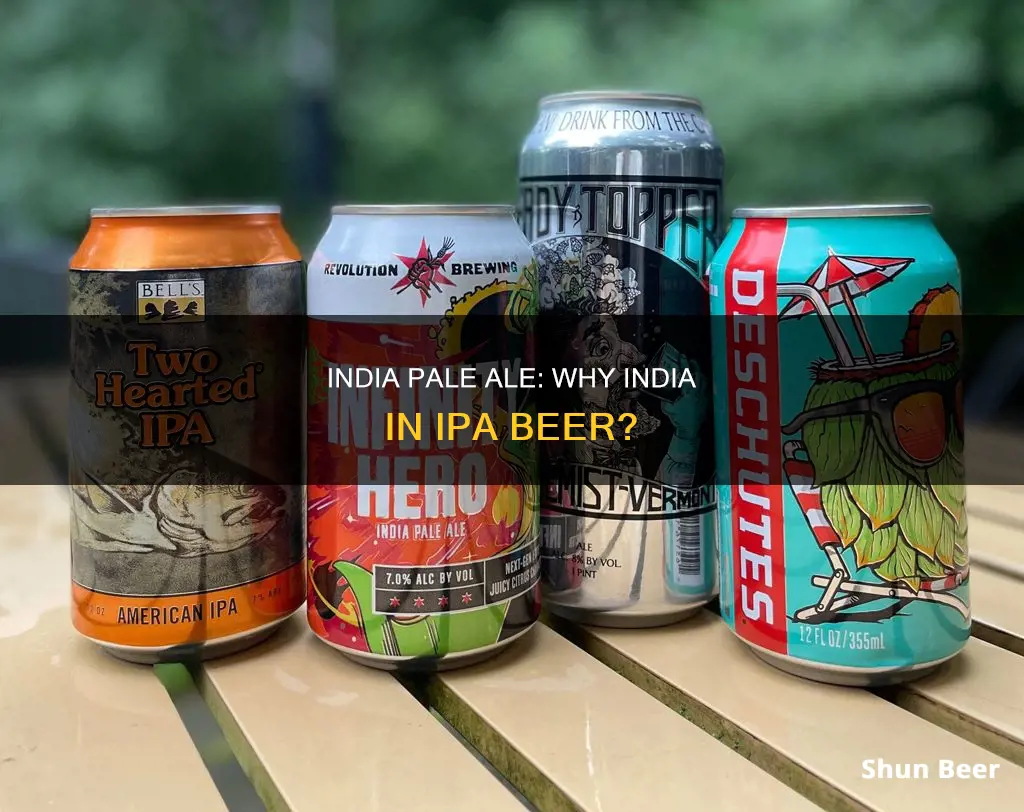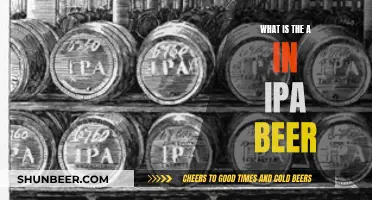
India Pale Ale (IPA) was created to allow the British to continue drinking beer while colonising India. At the time, it was difficult to brew beer in India due to the hot weather, and there was no widespread refrigeration, which made the fermentation process unpredictable. Beer shipments from Britain often went bad or stale. George Hodgson, a brewery owner, is credited with creating a beer that could survive the journey to India by harnessing the preservative effects of hops and alcohol. This new beer also created a new flavour and was paler in colour than other beers.
What You'll Learn
- IPA was created to allow the British to drink beer in India during colonisation
- It was too hot to brew beer in India, and beer would spoil before reaching the subcontinent
- Beer matured during the voyage to India, creating a new flavour
- IPA was originally an export beer shipped to India
- IPA is a hoppy beer style within the broader category of pale ale

IPA was created to allow the British to drink beer in India during colonisation
India Pale Ale (IPA) was created to allow the British to continue drinking beer during colonisation in India. At the time, India was a British colony, and the hot weather made it difficult to brew beer there. Without widespread refrigeration, the intense heat would cause fermentation to speed up, resulting in inconsistent and unpleasant-tasting brews.
Shipping beer to India from Britain was also challenging, as the beer would often spoil, become stale, or get infected during the long journey. George Hodgson, a brewery owner, is credited with creating a beer that could withstand the voyage. He brewed a strong, heavily hopped beer called October ale, which normally would have been aged like wine before drinking. This beer not only survived the journey but improved in flavour.
Hodgson's beer was then imitated by larger breweries, such as Bass, and became a popular drink among British soldiers and administrators in India. The beer also gradually became paler and more refreshing to suit the Indian climate. Thus, IPA was created to allow the British to drink beer in India during colonisation, adapting to the challenges of brewing and transporting beer in a hot climate.
Guinness Beer: High-Fructose Corn Syrup Content Explored
You may want to see also

It was too hot to brew beer in India, and beer would spoil before reaching the subcontinent
The climate in India posed a challenge to beer brewing during the period of British colonisation. The hot and wet weather conditions in the subcontinent were not conducive to brewing good beer, and the lack of widespread refrigeration technology made it difficult to control the fermentation process. As a result, beer brewed in India at the time often turned out inconsistent and unsuccessful.
The British, determined to enjoy their beloved beverage in India, sought a solution to this problem. They discovered that by increasing the amount of hops and alcohol in the beer, they could create a preservative effect that would prevent the beer from spoiling during the long journey from Britain to India. This led to the creation of the India Pale Ale (IPA), a beer style within the broader category of pale ale that is characterised by its strong hoppy flavour and higher alcohol content.
The India Pale Ale was designed to survive the intense journey to the Indian subcontinent, and it did so with remarkable success. The journey from Britain to India typically lasted four to six months, during which the hops and alcohol in the beer acted as natural preservatives, preventing the beer from going stale or becoming infected. The maturation that occurred during the voyage also resulted in the creation of new flavours and aromas, leading to the distinctive taste of IPAs that we know today.
While the IPA was created to withstand the challenges of transportation to India, it is important to note that it was not the only beer being shipped to the colony. Porter, for example, was also successfully exported to India and California. However, the IPA stood out due to its ability to retain its flavour and quality during the long voyage, making it a popular choice among British soldiers and administrators serving in India.
Guinness Beer's IBUs: The Bitter Truth Unveiled
You may want to see also

Beer matured during the voyage to India, creating a new flavour
The India Pale Ale (IPA) was born out of the need to provide beer for British soldiers and administrators in India, which was then under the rule of the British East India Company. Brewing beer in India was challenging due to the hot weather, and the lack of refrigeration made fermentation unpredictable, resulting in inconsistent and often unpleasant brews.
Shipping beer to India from Britain was also problematic, as the long journey of four to six months led to spoilage and staleness. George Hodgson, a brewer from London, is credited with creating a solution by brewing a strong, heavily hopped beer called October ale, which was typically aged like wine before consumption. This beer not only survived the voyage to India but also matured and improved in flavour during the journey.
The preservative effects of hops and alcohol played a crucial role in Hodgson's creation. The hops added a refreshing aroma and taste, while the alcohol content contributed to the maturation process during the extended shipping duration. The result was a beer that was not only preserved but also developed a new, stronger flavour and a paler colour compared to the darker ales commonly consumed by the British.
Hodgson's October ale served as a prototype for the IPA, and bigger brewers like Bass soon followed suit, creating their versions. Over time, the beer evolved into a weaker version, plain old pale ale, for the domestic market. However, with the advent of refrigeration, the original IPA began to fade away. It was later revived by American craft brewers in the 1970s, who recreated these robust ales with a generous amount of alcohol and hops.
Guinness Beer: Carbonation Secrets Revealed
You may want to see also

IPA was originally an export beer shipped to India
India Pale Ale, or IPA, was originally an export beer shipped to India. The beer was brewed in the UK in the 1780s and became popular among British soldiers and administrators serving in India, which was then under the control of the East India Company. The IPA was created to solve the problem of providing beer for the British Empire in the east, as it was too hot to brew beer in India. The IPA was designed to survive the gruelling four- to six-month journey from Britain to India intact.
The exact origins of the IPA are disputed. One common story is that a brewer named Hodgson created the IPA specifically to be exported to India. Hodgson's beer was a strong, heavily hopped beer called October beer, which was normally aged like wine before drinking. The beer not only survived the journey to India but was found to have improved in flavour. This beer became the prototype for the IPA, which gradually became paler and more refreshing to suit the Indian climate.
Hodgson's beer was soon imitated by bigger brewers such as Bass, and the IPA became a popular style of beer in England. However, with the advent of refrigeration, the need for a beer that could survive long journeys without spoiling diminished, and the IPA began to die out. It wasn't until the 1970s, when American craft brewers began recreating forgotten British beer styles, that the IPA was revived and brought back to Britain.
Today, the IPA is one of the most popular beer styles in the UK and the US, with a wide variety of styles and flavours available. The IPA has come a long way since its days as an export beer to India, but its name continues to pay homage to its original destination.
Guinness: A Manly Beer or Just Dark, Foamy Liquid?
You may want to see also

IPA is a hoppy beer style within the broader category of pale ale
India Pale Ale (IPA) is a hoppy beer style within the broader category of pale ale. Pale ales are some of the most popular types of beer around the world. They are named for their paler amber shade, dating back to the 1700s when British brewers began roasting lighter malts. Pale ales are a kind of bridge between lighter lagers and darker stouts.
IPA, on the other hand, is a class of its own within the pale ale category. The term "India" in IPA comes from the beer being originally exported to India, which was under the control of the British East India Company until 1858. The beer was formulated to survive long voyages by sea.
The IPA was invented in Britain, with British sailors loading up barrels of beer with hops, as hops were a preservative. The hops hung around in the beer for so long that they lost their fruity flavour and left a bitter-tasting beer.
The common story is that when the British Indian colonies were established, the British Indian army and workers in the East India Trading Company missed the beer from back home. They either couldn’t find a comparable brew in India or it was too hot to brew their own, and exports from the UK would often arrive contaminated or stale after months at sea.
It’s believed that British brewers adjusted their production methods to address this problem, adding more hops as a natural preservative. This would also increase the alcohol content and the intensity of the flavour, while extending the life of the beer to endure 4-6 months on a ship to India.
The long journey turned out to actually improve the quality and taste of the beer, which quickly became a hit in both Britain and India. This sought-after beverage was soon known as India Pale Ale, popular for its refreshing balance of fruity sweetness and bitter hops.
Demand for the export style of pale ale, which had become known as "India pale ale", developed in England around 1840 and India pale ale became a popular product in England.
In the late 20th century, craft beer revolution in the United States, brewers began seeking out old beer styles that had fallen out of vogue. The traditional IPA style was well-suited to model the intense flavour and aroma of American hops. The boom in popularity for IPA as a style spread down the west coast of the United States, then across the United States and eventually the world. It is estimated that over 40% of craft beer brewed in the United States can be classified as an IPA.
Guinness IPA Beer: GMO and Chemical Mystery Solved
You may want to see also
Frequently asked questions
IPA stands for India Pale Ale. It was first brewed in the UK in the 1780s and became popular among British soldiers and administrators serving in India.
It was too hot to brew beer in India, so a beer was needed that could survive the four-to-six-month journey from Britain intact.
Beer was loaded with hops, which have a preservative effect, and alcohol, which also acts as a preservative.
IPA is a style of beer, which is popular enough to be called "regular" beer. It is a type of pale ale but is made with more hops, giving it a stronger flavour.
There is nothing inherently strong about an IPA compared to other beers. Some IPAs are stronger than average regular beers, and some regular beers are stronger than the average IPA.







